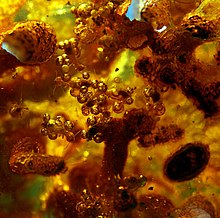Copal

Copal is a tree
It is available in different forms; the hard, amber-like yellow copal is a less expensive version, while the milky-white copal is more expensive.[citation needed]
Etymology
The word "copal" is derived from the
History and uses
Subfossil copal is well known from
By the 18th century, Europeans found it to be a valuable ingredient in making a good wood varnish. It became widely used in the manufacture of furniture and carriages. It was also sometimes used as a picture varnish.[5] By the late 19th and early 20th century, varnish manufacturers in England and America were using it on train carriages, greatly swelling its demand. In 1859, Americans consumed 68% of the East African trade, which was controlled through the Sultan of Zanzibar, with Germany receiving 24%. The American Civil War and the creation of the Suez Canal led to Germany, India, and Hong Kong taking the majority by the end of that century.[6]
Copal is still used by a number of indigenous peoples of Mexico and Central America as an incense, during sweat lodge ceremonies and sacred mushroom ceremonies.[1]
References
- ^ a b Stross (1997).
- ^ Platt (1998).
- ^ Hoffeins (2012).
- ^ Grimaldi (1996), pp. 16–20.
- ^ Mayer (1976), pp. 194–196.
- ^ Sunseri (2009), pp. 10–12.
Sources
- Grimaldi, David (1996). Amber: Window to the Past. American Museum of Natural History.
- Hoffeins, Christel (1 June 2012). "On Baltic amber inclusions treated in an autoclave". Polish Journal of Entomology / Polskie Pismo Entomologiczne. 81 (2): 165–183. .
- Mayer, Ralph (1976). The Artist's Handbook of Materials and Techniques. New York: Viking.
- Platt, Gary (6 June 1998). "Types of Amber, Copal & Resin". Archived from the original on 25 February 2010.
- Stross, Brian (1997). "Mesoamerican Copal Resins". U Mut Maya. 6: 177–186. Archived from the original on 12 February 2015 – via University of Texas at Austin.
- Sunseri, Thaddeus (2009). Wielding the Ax: State Forestry and Social Conflict in Tanzania, 1820-2000.
Further reading
- . Encyclopædia Britannica. Vol. 7 (11th ed.). 1911. p. 94.
